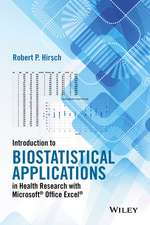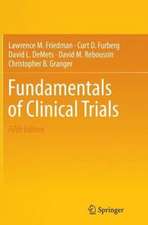Clinical Prediction Models: A Practical Approach to Development, Validation, and Updating: Statistics for Biology and Health
Autor Ewout W. Steyerbergen Limba Engleză Hardback – 20 oct 2008
| Toate formatele și edițiile | Preț | Express |
|---|---|---|
| Paperback (1) | 471.68 lei 6-8 săpt. | |
| Springer International Publishing – 14 aug 2020 | 471.68 lei 6-8 săpt. | |
| Hardback (2) | 496.60 lei 3-5 săpt. | +39.90 lei 7-13 zile |
| Springer International Publishing – aug 2019 | 496.60 lei 3-5 săpt. | +39.90 lei 7-13 zile |
| Springer – 20 oct 2008 | 1394.84 lei 6-8 săpt. |
Din seria Statistics for Biology and Health
- 20%
 Preț: 633.23 lei
Preț: 633.23 lei - 17%
 Preț: 352.01 lei
Preț: 352.01 lei - 20%
 Preț: 776.71 lei
Preț: 776.71 lei - 20%
 Preț: 1376.32 lei
Preț: 1376.32 lei - 18%
 Preț: 883.59 lei
Preț: 883.59 lei - 5%
 Preț: 843.91 lei
Preț: 843.91 lei -
 Preț: 397.16 lei
Preț: 397.16 lei - 20%
 Preț: 1002.67 lei
Preț: 1002.67 lei - 18%
 Preț: 1395.32 lei
Preț: 1395.32 lei - 5%
 Preț: 1102.10 lei
Preț: 1102.10 lei - 5%
 Preț: 874.83 lei
Preț: 874.83 lei - 15%
 Preț: 657.39 lei
Preț: 657.39 lei - 18%
 Preț: 960.93 lei
Preț: 960.93 lei - 15%
 Preț: 585.90 lei
Preț: 585.90 lei - 5%
 Preț: 852.69 lei
Preț: 852.69 lei - 18%
 Preț: 903.62 lei
Preț: 903.62 lei - 5%
 Preț: 721.40 lei
Preț: 721.40 lei - 15%
 Preț: 653.46 lei
Preț: 653.46 lei - 18%
 Preț: 2114.90 lei
Preț: 2114.90 lei - 18%
 Preț: 1108.99 lei
Preț: 1108.99 lei - 5%
 Preț: 821.39 lei
Preț: 821.39 lei - 5%
 Preț: 849.02 lei
Preț: 849.02 lei - 15%
 Preț: 653.14 lei
Preț: 653.14 lei - 18%
 Preț: 958.56 lei
Preț: 958.56 lei - 5%
 Preț: 722.69 lei
Preț: 722.69 lei - 18%
 Preț: 728.74 lei
Preț: 728.74 lei - 18%
 Preț: 943.22 lei
Preț: 943.22 lei - 5%
 Preț: 1092.43 lei
Preț: 1092.43 lei - 15%
 Preț: 594.21 lei
Preț: 594.21 lei - 5%
 Preț: 377.87 lei
Preț: 377.87 lei - 18%
 Preț: 1124.60 lei
Preț: 1124.60 lei - 18%
 Preț: 1220.12 lei
Preț: 1220.12 lei - 15%
 Preț: 632.98 lei
Preț: 632.98 lei - 18%
 Preț: 1394.84 lei
Preț: 1394.84 lei -
 Preț: 389.11 lei
Preț: 389.11 lei - 18%
 Preț: 959.98 lei
Preț: 959.98 lei
Preț: 1394.84 lei
Preț vechi: 1701.02 lei
-18% Nou
Puncte Express: 2092
Preț estimativ în valută:
266.90€ • 279.41$ • 220.84£
266.90€ • 279.41$ • 220.84£
Carte tipărită la comandă
Livrare economică 05-19 aprilie
Preluare comenzi: 021 569.72.76
Specificații
ISBN-13: 9780387772431
ISBN-10: 038777243X
Pagini: 497
Ilustrații: XXVIII, 500 p.
Dimensiuni: 155 x 235 x 28 mm
Greutate: 0.84 kg
Ediția:2009
Editura: Springer
Colecția Springer
Seria Statistics for Biology and Health
Locul publicării:New York, NY, United States
ISBN-10: 038777243X
Pagini: 497
Ilustrații: XXVIII, 500 p.
Dimensiuni: 155 x 235 x 28 mm
Greutate: 0.84 kg
Ediția:2009
Editura: Springer
Colecția Springer
Seria Statistics for Biology and Health
Locul publicării:New York, NY, United States
Public țintă
ResearchCuprins
Applications of prediction models.- Study design for prediction models.- Statistical Models for Prediction.- Overfitting and optimism in prediction models.- Choosing between alternative statistical models.- Dealing with missing values.- Case study on dealing with missing values.- Coding of Categorical and Continuous Predictors.- Restrictions on candidate predictors.- Selection of main effects.- Assumptions in regression models:Additivity and linearity.- Modern estimation methods.- Estimation with external information.- Evaluation of performance.- Clinical Usefulness.- Validation of Prediction Models.- Presentation formats.- Patterns of external validity.- Updating for a new setting.- Updating for multiple settings.- Prediction of a binary outcome:30-day mortality after acute myocardial infarction.- Case study on survival analysis:prediction of secondary cardiovascular events.- Lessons from case studies.
Recenzii
From the reviews:
"This book covers an important topic, because these prediction models are essential for individualizing diagnostic and treatment decision making. The topic is of increased importance as evidence-based medicine is increasingly implemented and as scientific and technological advances reveal new potential predictors of outcome. This book presents an approach for developing, validating, and updating prediction models.… [I]t provides ways to optimally utilize regression techniques to predict an outcome.… This book is written in a clear and accessible style.… [A]valuable resource for anyone interested in developing or applying a prediction model." (Todd A. Alonzo, American Journal of Epidemiology, 2009; Vol. 170, No. 4)
"Overall I think this is a well-written book, which will have a wide appeal. The idea of defining a strategy to deal with clinical prediction problems might be somewhat controversial, but considering the variable quality of statisticalanalyses that appear in the medical literature, I believe such an approach is desirable. The book appears to have struck a good balance between practical examples and descriptions of statistical techniques.... It is refreshing to see a practical book applying many modern regression techniques to real problems." (David Ohlssen, Journal of Biopharmaceutical Statistics, Issue 6, 2009)
"Dr Steyerberg … aims to provide an insight and also a practical illustration on how modern statistical concepts and regression methods can be applied in medical prediction outcomes. The book…will be of interest to those who work in medical cybernetics and indeed all cybernetics and systems researchers who are studying such medical problems and wish to apply statistical approaches and methodologies. It is worth examining the detailed contents list … and individual chapters may be of particular value to potential readers." (C. J. H. Mann, Kybernetes, Vol. 38 (6), 2009)
"The book … will be of interest to those who work in medical cybernetics and indeed all cybernetics and systems researchers who are studying such medical problems and wish to apply statistical approaches and methodologies." (C. J. H. Mann, Kybernetes, Vol. 38, No. 6, 2009)
“…and excellent practical guide for developing, assessing and updating clinical models both for disease prognosis and diagnosis. The book’s clinical focus in this era of evidence-based medicine is refreshing and serves as a much-needed addition to statistical modeling of clinical data. The book assumes a basic familiarity with modeling using generalized linear models, focusing instead on the real challenges facing applied biostatisticians and epidemiologists wanting to create useful models: dealing with a plethora of model choices, small sample sizes, many candidate predictors and missing data. This is an example-based book illuminating the vagaries of clinical data and offering sound practical advice on data exploration, model selection and data presentation. …The author uses simple simulations using a few reproducible R commands to motivate the use of imputation methods and shrinkage. These simple but illuminating illustrations are one of the highlights of the book and serve as excellent pedagogical tools for motivating good statistical thinking. …” (International Statistical Review 2009, 77, 2)
“This is an excellent text that should be read by anyone performing prediction modeling. … the text has three audiences epidemiologists and applied biostatisticians who want to develop or apply a prediction model health care professionals who want to judge a study that presents a prediction model and theoretical researchers … . I found the book very useful and I believe clinicians and policy makers will be similarly well served. … All are excellent summaries for readers and provide links to resources for further investigation.” (Chris Andrews, Technometrics, Vol. 53 (1), February, 2011)
"This book covers an important topic, because these prediction models are essential for individualizing diagnostic and treatment decision making. The topic is of increased importance as evidence-based medicine is increasingly implemented and as scientific and technological advances reveal new potential predictors of outcome. This book presents an approach for developing, validating, and updating prediction models.… [I]t provides ways to optimally utilize regression techniques to predict an outcome.… This book is written in a clear and accessible style.… [A]valuable resource for anyone interested in developing or applying a prediction model." (Todd A. Alonzo, American Journal of Epidemiology, 2009; Vol. 170, No. 4)
"Overall I think this is a well-written book, which will have a wide appeal. The idea of defining a strategy to deal with clinical prediction problems might be somewhat controversial, but considering the variable quality of statisticalanalyses that appear in the medical literature, I believe such an approach is desirable. The book appears to have struck a good balance between practical examples and descriptions of statistical techniques.... It is refreshing to see a practical book applying many modern regression techniques to real problems." (David Ohlssen, Journal of Biopharmaceutical Statistics, Issue 6, 2009)
"Dr Steyerberg … aims to provide an insight and also a practical illustration on how modern statistical concepts and regression methods can be applied in medical prediction outcomes. The book…will be of interest to those who work in medical cybernetics and indeed all cybernetics and systems researchers who are studying such medical problems and wish to apply statistical approaches and methodologies. It is worth examining the detailed contents list … and individual chapters may be of particular value to potential readers." (C. J. H. Mann, Kybernetes, Vol. 38 (6), 2009)
"The book … will be of interest to those who work in medical cybernetics and indeed all cybernetics and systems researchers who are studying such medical problems and wish to apply statistical approaches and methodologies." (C. J. H. Mann, Kybernetes, Vol. 38, No. 6, 2009)
“…and excellent practical guide for developing, assessing and updating clinical models both for disease prognosis and diagnosis. The book’s clinical focus in this era of evidence-based medicine is refreshing and serves as a much-needed addition to statistical modeling of clinical data. The book assumes a basic familiarity with modeling using generalized linear models, focusing instead on the real challenges facing applied biostatisticians and epidemiologists wanting to create useful models: dealing with a plethora of model choices, small sample sizes, many candidate predictors and missing data. This is an example-based book illuminating the vagaries of clinical data and offering sound practical advice on data exploration, model selection and data presentation. …The author uses simple simulations using a few reproducible R commands to motivate the use of imputation methods and shrinkage. These simple but illuminating illustrations are one of the highlights of the book and serve as excellent pedagogical tools for motivating good statistical thinking. …” (International Statistical Review 2009, 77, 2)
“This is an excellent text that should be read by anyone performing prediction modeling. … the text has three audiences epidemiologists and applied biostatisticians who want to develop or apply a prediction model health care professionals who want to judge a study that presents a prediction model and theoretical researchers … . I found the book very useful and I believe clinicians and policy makers will be similarly well served. … All are excellent summaries for readers and provide links to resources for further investigation.” (Chris Andrews, Technometrics, Vol. 53 (1), February, 2011)
Textul de pe ultima copertă
This book provides insight and practical illustrations on how modern statistical concepts and regression methods can be applied in medical prediction problems, including diagnostic and prognostic outcomes. Many advances have been made in statistical approaches towards outcome prediction, but these innovations are insufficiently applied in medical research. Old-fashioned, data hungry methods are often used in data sets of limited size, validation of predictions is not done or done simplistically, and updating of previously developed models is not considered. A sensible strategy is needed for model development, validation, and updating, such that prediction models can better support medical practice.
Clinical prediction models presents a practical checklist with seven steps that need to be considered for development of a valid prediction model. These include preliminary considerations such as dealing with missing values; coding of predictors; selection of main effects and interactions for a multivariable model; estimation of model parameters with shrinkage methods and incorporation of external data; evaluation of performance and usefulness; internal validation; and presentation formats. The steps are illustrated with many small case-studies and R code, with data sets made available in the public domain. The book further focuses on generalizability of prediction models, including patterns of invalidity that may be encountered in new settings, approaches to updating of a model, and comparisons of centers after case-mix adjustment by a prediction model.
The text is primarily intended for clinical epidemiologists and biostatisticians. It can be used as a textbook for a graduate course on predictive modeling in diagnosis and prognosis. It is beneficial if readers are familiar with common statistical models in medicine: linear regression, logistic regression, and Cox regression. The book is practical in nature. But it provides a philosophical perspective ondata analysis in medicine that goes beyond predictive modeling. In this era of evidence-based medicine, randomized clinical trials are the basis for assessment of treatment efficacy. Prediction models are key to individualizing diagnostic and treatment decision making.
Ewout Steyerberg (1967) is Professor of Medical Decision Making, in particular prognostic modeling, at Erasmus MC–University Medical Center Rotterdam, the Netherlands. His work on prediction models was stimulated by various research grants including a fellowship from the Royal Netherlands Academy of Arts and Sciences. He has published over 250 peer-reviewed articles in collaboration with many clinical researchers, both in methodological and medical journals.
Clinical prediction models presents a practical checklist with seven steps that need to be considered for development of a valid prediction model. These include preliminary considerations such as dealing with missing values; coding of predictors; selection of main effects and interactions for a multivariable model; estimation of model parameters with shrinkage methods and incorporation of external data; evaluation of performance and usefulness; internal validation; and presentation formats. The steps are illustrated with many small case-studies and R code, with data sets made available in the public domain. The book further focuses on generalizability of prediction models, including patterns of invalidity that may be encountered in new settings, approaches to updating of a model, and comparisons of centers after case-mix adjustment by a prediction model.
The text is primarily intended for clinical epidemiologists and biostatisticians. It can be used as a textbook for a graduate course on predictive modeling in diagnosis and prognosis. It is beneficial if readers are familiar with common statistical models in medicine: linear regression, logistic regression, and Cox regression. The book is practical in nature. But it provides a philosophical perspective ondata analysis in medicine that goes beyond predictive modeling. In this era of evidence-based medicine, randomized clinical trials are the basis for assessment of treatment efficacy. Prediction models are key to individualizing diagnostic and treatment decision making.
Ewout Steyerberg (1967) is Professor of Medical Decision Making, in particular prognostic modeling, at Erasmus MC–University Medical Center Rotterdam, the Netherlands. His work on prediction models was stimulated by various research grants including a fellowship from the Royal Netherlands Academy of Arts and Sciences. He has published over 250 peer-reviewed articles in collaboration with many clinical researchers, both in methodological and medical journals.
Caracteristici
A sensible strategy to all three aspects (development, validation, updating) is relevant to provide up-to-date prognostic models that can reliably support medical practice Includes supplementary material: sn.pub/extras Request lecturer material: sn.pub/lecturer-material
Notă biografică
Ewout Steyerberg worked for 25 years at Erasmus Medical Center in Rotterdam before moving to Leiden where he is now Professor of Clinical Biostatistics and Medical Decision Making and chair of the Department of Biomedical Data Sciences at Leiden University Medical Center. His research has covered a broad range of methodological and medical topics, which is reflected in hundreds of peer-reviewed methodological and applied publications. His methodological expertise is in the design and analysis of randomized controlled trials, cost-effectiveness analysis, and decision analysis. His methodological research focuses on the development, validation and updating of prediction models, as reflected in a textbook (Springer, 2009). His medical fields of application include oncology, cardiovascular disease, internal medicine, pediatrics, infectious diseases, neurology, surgery and traumatic brain injury.





